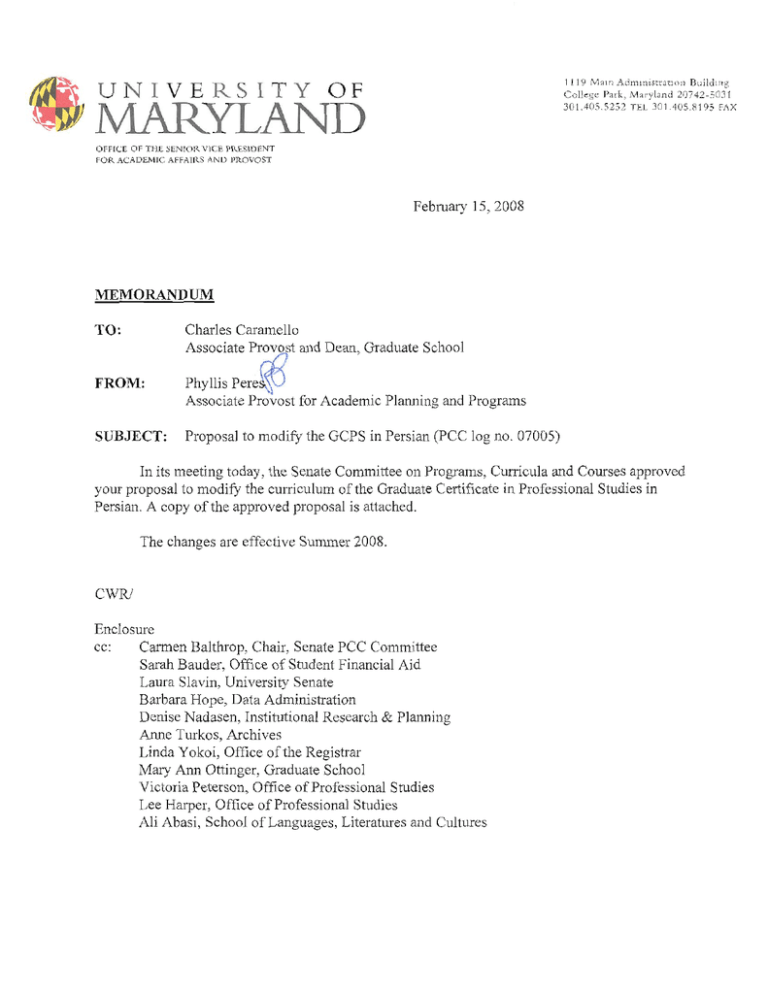Document 14300755
advertisement

PROPOSAL FOR NEW INSTRUCTIONAL PROGRAM UNIVERSITY OF MARYLAND AT COLLEGE PARK, MARYLAND REVISED Graduate Certificate in Professional Studies in Persian PROPOSED INITIATION DATE: Spring 2008 1 I. OVERVIEW and RATIONALE A. Briefly describe the nature of the proposed program and explain why the institution should offer it. [You may want to refer to student demand, market demand for graduates, institutional strengths, disciplinary trends, synergy with existing programs, and/or institutional strategic priorities.] This is a revision of the existing Graduate Certificate in Professional Studies in Persian. The University of Maryland is committed to providing educational programs that meet the needs of a variety of audiences. As part of our graduate offerings, the Master of Professional Studies and the Graduate Certificate in Professional Studies are career-focused degrees designed for students who wish to increase their subject-matter knowledge as well as prepare themselves for new challenges related to their professional areas. These programs are administered by the Office of Professional Studies (OPS), with academic oversight provided by the Graduate School. The School of Languages, Literatures and Cultures (SLLC), the College of Arts and Humanities, and the campus as a whole are committed to the enhancement of existing strengths in Middle East studies, as demonstrated by the rapid development of its GCPS Arabic and GCPS/MPS Persian programs. There is a growing need in the country to educate individuals who have in-depth knowledge and understanding of the languages and cultures of the Middle East. Demand for the programs is increasing. OPS is committed to the educational needs of professional working adults, and this includes providing flexibility in its course offerings. The current GCPS in Persian requires students to take 5 courses (see below), and as those are the only courses approved for the certificate, students are restricted in terms of which semester they can begin the program. If the list of approved courses is expanded to include all courses currently approved for the MPS in Persian, then students can start in any semester (no Persian courses have prerequisites). This expansion of course offerings also allows each student to select, beyond the core courses, a curriculum which would best meet his/her professional needs. In the revised GCPS in Persian program, students will take 2 core courses, PERS 641, Iranian Media & International Relations, and PERS 642, Political Issues in Contemporary Iran, and choose an additional 3 electives to make a total of 5 courses (15 credits). All courses have been approved by VPAC, including PERS 632, PERS 642, PERS 662, and PERS 672, which previously had one-time approval by the ARHU College PCC. 2 Current program 1. PERS 411 Readings in Iranian Islam Revised program 1. PERS 641 Iranian Media & Int’l Relations (Core) 2. PERS 642 Political Issues in Contemporary Iran (Core) 2. PERS 601 Modern Persian Literature 3. PERS 611 Practicum in Translation & Interpreting 4. PERS 641 Iranian Media & Int’l Relations Electives: choose 3 from among the following 7 courses 1. PERS 411 Readings in Iranian Islam 5. PERS 689 Special Topics in Persian Studies 2. PERS 601 Modern Persian Literature 3. PERS 611 Practicum in Translation & Interpreting 4. PERS 632 Film and Popular Culture in the Persian-speaking World 5. PERS 662 Persian Sociolinguistics 6. PERS 672 Persian Culture & Commerce 7. PERS 689 Special Topics in Persian Studies B. How big is the program expected to be? From what other programs serving current students, or from what new populations of potential students, onsite or offsite, are you expecting to draw? The program will draw a professional audience. Initial enrollment is anticipated at 7 – 10 students. Expected growth is to reach a maximum enrollment of 15 – 20 students. II. CURRICULUM A. Provide a full catalog description of the proposed program, including educational objectives and any areas of concentration. Topics covered now include Persian language and literature, the Iranian political system, the relationship of the media to the state, Islamic business practices, trade policies, and related issues. All courses are taught in Persian. Students simulate living in a Persian-speaking environment in the following ways: five hours a day of structured language learning; communication in Persian throughout the day with native-speaking language partners drawn from among the 800 Persian-speaking students at UMD; a dedicated Persian multimedia study area; and visiting speakers, field trips, and other formal and informal cultural experiences. 3 B. List the courses (number, title, semester credit hours) that would constitute the requirements and other components of the proposed program. Provide a catalog description for any courses that will be newly developed or substantially modified for the program. Students will take 5 of the following courses to earn the Graduate Certificate in Professional Studies in Persian (as revised) Core courses (required of all students): PERS 641 Iranian Media and International Relations (3 credits): Political interests and diplomatic positions of Iran in the contemporary international context as reflected in its print and electronic media. In Persian. PERS 642 Political Issues in Contemporary Iran (3 credits): Analysis of current political context in Iran; impact of modernization and westernization. In Persian. Elective courses: PERS 411 Readings in Iranian Islam (3): In-depth study of Iranian Islam via Islamic texts. Develops competency in speaking, reading, writing, and listening comprehension at advanced level. In Persian. PERS 601 Modern Persian Literature (3): Selected readings in Persian poetry, fiction, and drama covering topics related to contemporary Iranian society and culture. In Persian. PERS 611 Practicum in Translation and Interpreting (3 credits): Analysis, translation and interpreting of literary, expository, and oral texts, mainly from English to Persian. Focus on interdependence of language, context and culture. In Persian and English. PERS 632 Film and Popular Culture in the Persian-speaking World (3 credits): Study of socio-cultural, political and identity issues in the Persianspeaking world through visual media, primarily film. In Persian. PERS 662 Persian Sociolinguistics (3 credits): Study of impact of social and regional factors on spoken and written usage. In Persian. PERS 672 Culture and Commerce in the Persian-Speaking World (3 credits): Major issues in Iranian business culture; relations between state and private sector,; effects of globalization. In Persian. PERS 689 Special Topics in Persian Studies (3 credits): An in-depth analysis of a particular aspect of Persian studies. In Persian. 4 C. Describe any selective admissions policy or special criteria for students selecting this field of study. The admissions policy will reflect current university standards, including the prerequisite bachelor’s degree and a 3.0 GPA cumulative average. Official undergraduate transcripts from all colleges attended must be provided. Professional experience may be substituted for an entrance exam and students must complete all prerequisite courses in the program. All applicants are required to take a language proficiency examination offered by the Persian program prior to admission for course placement. III. STUDENT LEARNING OUTCOMES AND ASSESSMENT The purpose of this assessment plan is to set clear guidelines, identify articulated outcomes, and ensure avenues for continuous improvement for each graduate certificate and Master’s degree program managed by the Office of Professional Studies and housed in the Graduate School. It is our mission to provide programs that meet UMCP’s institutional goals and objectives for educational activities. 5 Student Learning Outcomes 1. Students will demonstrate in-depth knowledge of Persian culture 2. Students will demonstrate professional proficiency in spoken Persian at the superior level 3. Students will demonstrate professional proficiency in written Persian at the superior level Assessment Measures and Criteria Assessment Schedule Measurement: Final project in a course in Persian culture, politics, and/or media Yearly; second semester Criterion: 80% of students will earn a grade of B (3.0 on a 4.0 scale) on this assessment Measurement: Oral proficiency interview (known as OPI) will be conducted by program faculty Yearly; second semester Criterion: 80% of students will perform successfully in this interview at ILR* level 2+ (ACTFL** advanced plus) Measurement: Final writing assignment in PERS 641 or PERS 642 Yearly; second semester Criterion: 80% of students will reach ILR* level 2+ on this assignment (ACTFL** superior) * ILR: Interagency Language Roundtable Scale (US government) **ACTFL: American Council on the Teaching of Foreign Languages Superior oral proficiency: The Superior level is characterized by the ability to participate effectively in most formal and informal conversations on practical, social, professional, and abstract topics. Using extended discourse, the speaker can explain in detail, hypothesize on concrete and abstract topics, and support or defend opinions on controversial matters. Superior written proficiency: Speakers read and express themselves effectively in most informal and formal writing on practical, social, and professional topics treated both abstractly and concretely. Read and present well-developed ideas, opinions, arguments, and hypotheses through extended discourse. Control structures, both general specialized/professional vocabulary, spelling or symbol production, punctuation, diacritical marks, cohesive devices, and other aspects of written form and organization with no pattern of error to distract the reader. IV. FACULTY AND ORGANIZATION A. Who will provide academic direction and oversight for the program? The degree will be housed in the Graduate School. Continuing academic and program direction will be provided by the Program Oversight Committee while the project itself will be managed by the Office of Professional Studies. Members of the Program Oversight Committee include: 6 Graduate Director (academic chair): Pierre Verdaguer Associate Director, School of Languages, Literatures, and Cultures College of Arts and Humanities Coordinator: Ali Reza Abasi Lecturer, School of Languages, Literatures, and Cultures College of Arts and Humanities Graduate School Representative: Charles Caramello, Dean Graduate School OPS Program Manager (program management chair): Lee Ellen Harper, Program Manager Professional Studies Faculty selection and appointments are made by the School of Languages, Literatures, and Cultures. All faculty will be members of the Graduate Faculty and approved to teach by the Dean of the Graduate School. Michael Long, Director of SLLC, is responsible for all hiring decisions, in close consultation with Ahmed Karimi, Director of the Persian Studies Program, and Ali Abasi, Coordinator of the Persian Flagship Program. In addition, Amy Weinberg, Associate Director of the Center for the Advanced Study of Language and co-PI of the University’s Flagship Program, has oversight responsibility in the recruitment and hiring of faculty. B. If the program is not to be housed and administered within a single academic unit, provide details of its administrative structure. The Master of Professional Studies and the Graduate Certificate in Professional Studies will be housed in the Graduate School and managed by the Office of Professional Studies. A faculty member from the college providing the foundation courses will serve as Graduate Director and will provide the academic leadership for the team. OPS will manage and coordinate the Program Oversight Committee as well as all other components of the program. V. OFF-CAMPUS PROGRAMS (if applicable) Not applicable 7 VI. OTHER ISSUES A. Describe any cooperative arrangements with other institutions or organizations that will be important for the success of this program. Not applicable B. Will the program require or seek accreditation? Is it intended to provide certification or licensure for its graduates? Are there academic or administrative constraints as a consequence? Not applicable VII. COMMITMENT TO DIVERSITY The University of Maryland is an equal opportunity institution with respect to both education and employment. The University does not discriminate on the basis of race, color, national origin, sex, age, or handicap in admission or access to, or treatment or employment in, its programs and activities as required by federal (Title VI, Title IX, Section 504) and state laws and regulations. Through its actions and statements of policy the University of Maryland has demonstrated a commitment to diversity by creating programs of study which explore the experiences, perspectives, and contributions of a wide variety of cultures, groups, and individuals; and has sought to create a campus environment which encourages tolerance and respect for individuals regardless of differences in age, race, ethnicity, sex, religion, disability, sexual orientation, class, political affiliation, and national origin. VIII. REQUIRED PHYSICAL RESOURCES A. Additional library and other information resources required to support the proposed program. You must include a formal evaluation by Library staff. This program is a revision of an existing GCPS program and does not require additional funds for resources. B. Additional facilities, facility modifications, and equipment that will be required. This is to include faculty and staff office space, laboratories, special classrooms, computers, etc. This program is a revision of an existing GCPS program and does not require additional facilities. C. Impact, if any, on the use of existing facilities and equipment. Examples are laboratories, computer labs, specially equipped classrooms, and access to computer servers. 8 This program is a revision of an existing GCPS program and does not require additional resources. IX. RESOURCE NEEDS AND SOURCES A. List new courses to be taught and needed additional sections of existing courses. Describe the anticipated advising and administrative loads. Indicate the personnel resources (faculty, staff, and teaching assistants) that will be needed to cover all these responsibilities. This program is a revision of the current GCPS in Persian. It includes courses from the current certificate program and adds existing courses focusing on politics and business. The program is financed by grant and self-support funding. All resources needed to administer and implement the program come from these sources. B. List new faculty, staff, and teaching assistants needed for the responsibilities in A, and indicate the source of the resources for hiring them No new University of Maryland faculty or staff will be needed for this program. Some instructors may be compensated using overloads. Other faculty may include retired faculty and professionals in the field. C. Some of these teaching, advising, and administrative duties may be covered by existing faculty and staff. Describe your expectations for this, and indicate how the current duties of these individuals will be covered, and the source of any needed resources. Approval of all faculty overloads for teaching and advising will be in accordance with University of Maryland policy and procedures. OPS is responsible for the overall administrative management of the program. D. Identify the source to pay for the required physical resources identified in Section VIII. above. Grant and tuition revenue will be used to cover the program expenses. E. List any other required resources and the anticipated source for them Not applicable F. Complete the additional proposal and financial tables as required by MHEC. Not applicable for MPS/GCPS programs. 9 Additional Campus Approvals: Victoria M. Peterson, Assistant Dean, Office of Professional Studies Judith K. Broida, Associate Provost and Dean, Office of Professional Studies 10






